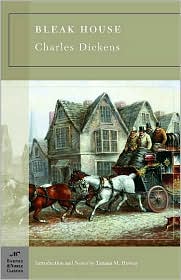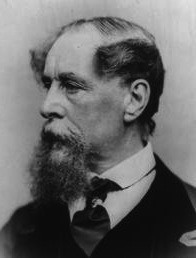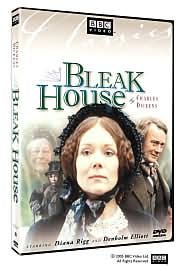The dense fog is densest…near that leaden-headed old obstruction …the High Court of Chancery.”
Written in 1853, when Dickens was at his peak, Bleak House is often considered Dickens’s best novel. Set in the 1850s, the novel tells several interconnected stories involving dozens of characters from all levels of society, giving a broad picture of life in London and in the countryside during this period. As is often the case with Dickens, his satire and humor enliven his sometimes dark subjects, without blunting his criticism of bureaucracy and the mistreatment of children. The novel is huge, not just in terms of length but in its universal themes, its characterizations, and the magnitude of its reach.
in 1853, when Dickens was at his peak, Bleak House is often considered Dickens’s best novel. Set in the 1850s, the novel tells several interconnected stories involving dozens of characters from all levels of society, giving a broad picture of life in London and in the countryside during this period. As is often the case with Dickens, his satire and humor enliven his sometimes dark subjects, without blunting his criticism of bureaucracy and the mistreatment of children. The novel is huge, not just in terms of length but in its universal themes, its characterizations, and the magnitude of its reach.
Esther Summerson, the illegitimate daughter of Lady Dedlock and Captain Hawdon, an early lover, is raised in secrecy by a resentful aunt. After the aunt’s death, Esther joins the household of the kindly Mr. Jarndyce, who is also mentoring Ada Clare and Richard Carstone, Ada’s cousin. Richard, Ada, and Mr. Jarndyce have been involved for years in a lawsuit, Jarndyce v. Jarndyce, about the terms of an old will, and this lawsuit, which has continued interminably in the High Court of Chancery, is the inspiration for the satire Dickens directs toward British bureaucracy and the paperwork which paralyzes it.

As the lives of Esther, Lady Dedlock, Ada, Richard, and Mr. Jarndyce unfold, the reader also learns about the lives of those who come into peripheral contact with them. Capt. Hawdon (Nemo), for example, is found dead by a sad, little street waif named Jo, whose miserable life offers little chance of improvement. An unprincipled lawyer is murdered, adding mystery to the novel. Dickens emphasizes the way characters actually behave, paying scant attention to their inner thoughts, but he individualizes them and brings them vibrantly to life through their actions (though some, such as Esther and Mr. Jarndyce, sometimes appear too saintly).
Humor perm eates the novel, with some characters, particularly those involved in law, serving as caricatures. The touching romance of Esther and Allan Woodcourt, a physician, echoes throughout the novel, despite his long absences and her bout with smallpox, and contrasts with Lady Dedlock’s sad remembrances of her own past. Symbols, such as the ever-present London fog, emphasize the theme of isolation.
eates the novel, with some characters, particularly those involved in law, serving as caricatures. The touching romance of Esther and Allan Woodcourt, a physician, echoes throughout the novel, despite his long absences and her bout with smallpox, and contrasts with Lady Dedlock’s sad remembrances of her own past. Symbols, such as the ever-present London fog, emphasize the theme of isolation.
Throughout this doorstop-sized novel, Dickens’s treatment of the characters and his ability to bring the period to life create lively reading. His empathy with the underdog and his depiction of the inequities of the society combine with mystery, romance, and Esther’s coming-of-age to make this a vital novel, full of life, conveying a dramatic picture of mid-19th century British life and the lessons to be learned from it.
Notes: More than one film adaptation of this novel is available, including one starring Diana Rigg (shown here).
Also reviewed here are three other Dickens novels: HARD TIMES, THE MYSTERY OF EDWIN DROOD, and NICHOLAS NICKLEBY. See Authors tab at top of the Home page, if interested.
